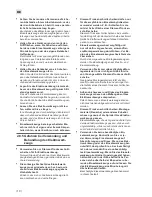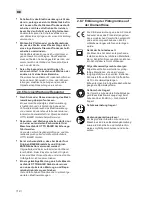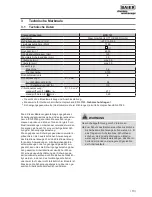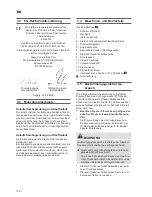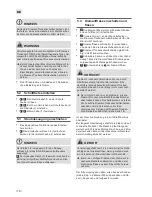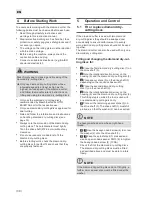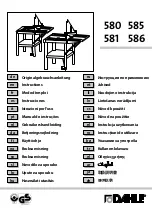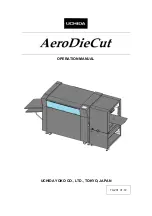
| 23 |
b) Avoid physical contact with earthed
surfaces such as pipes, heaters, cookers
and refrigerators.
There is an increased risk of an electric shock if
your body is earthed.
c) Keep power tools away from rain and
moisture.
The ingress of water into a power tool increases
the risk of an electric shock.
d) Do misuse the cable in any way by using it
to carry or hang up the power tool or to pull
the plug out of the socket. Keep the cable
away from heat, oil, sharp edges and moving
machine parts.
Damaged or kinked cables increase the risk of
an electric shock.
e) When working with a power tool outdoors,
use only extension leads that are suitable for
outdoor use.
Use of an extension lead suitable for outdoor
use reduces the risk of electric shock.
f) If the use of the power tool in a damp
environment is unavoidable, use a residual-
current circuit breaker.
Use of a residual-current circuit breaker (RCCB
with 10 mA maximum tripping current) reduces
the risk of an electric shock.
2.5 Safety of people
a) Always work carefully, attentively and
sensibly when using a power tool. Do not
use the power tools if you are tired or are
under the influence of drugs, alcohol or
medication.
A moment of inattention while using the power
tool can result in serious injuries.
b) Wear personal protective equipment and
always wear goggles.
The wearing of personal protective equipment,
such as dust mask, non-slip safety shoes,
helmet or ear protectors, depending on the type
and application of the power tools, reduces the
risk of injuries.
c) Avoid accidental switching on of the power
tool. Ensure that the power tool is switched
off before connecting it to the mains power
supply and/or connecting the battery and
before picking up or carrying the tool.
If you have your finger on the switch when
carrying the power tool or you connect the tool
to the power supply when it is switched on, this
can lead to accidents.
d) Remove the adjusting tools or wrenches
before switching on the power tool.
A tool or wrench in a rotating part of the tool can
result in injuries.
e) Avoid abnormal postures when working.
Ensure you are standing firmly and maintain
your balance at all times.
This will enable you to control the power tool
better in unexpected situations.
f) Wear suitable clothing. Do not wear loose
clothing or jewellery. Keep your hair,
clothing and gloves away from moving parts.
Loose clothing, jewellery and long hair can get
caught in moving parts.
g) If dust extraction and collection devices
can be installed, ensure that these are
connected and are used correctly.
Use of a dust extraction system can reduce the
hazards caused by dust.
2.6 Using and handling the power
tool
a) Do not overload the tool. Use the intended
power tool for your work.
You work better and safer within the given power
range if you use the suitable power tool.
b) Do not use a power tool whose switch is
defective.
A power tool which can no longer be switched
on or off is dangerous and must be repaired.
c) Remove the plug from the plug socket and/
or remove the battery before carrying out
tool adjustments, changing accessories or
placing the tool aside.
This precautionary measure prevents
unintentional starting of the power tool.
d) Store power tools out of the reach of
children when not in use. Do not allow
people to use the tool unless they are
familiar with it, or if they have not read this
instruction manual.
Power tools are dangerous if they are used by
inexperienced people.
e) Maintain power tools with care. Check
whether moving parts are in proper working
order and do not jam, whether parts are
broken or damaged in such a way that they
impair the function of the power tool. Have
damaged parts repaired before using the
tool.
Many accidents are caused by poorly serviced
and maintained power tools.
f) Keep cutting tools sharp and clean at all
times.
Carefully maintained cutting tools with sharp
cutting edges jam less easily and are easier to
control.


